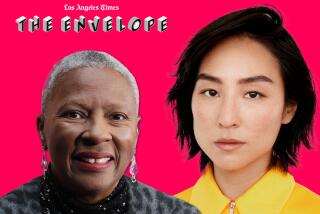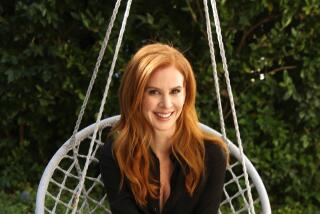Good old days not so simple in ‘Samantha’
- Share via
Funny thing about the good old days: They weren’t all that great for a lot of people.
That’s one of the tart notions undercutting the sweetness in “Samantha: An American Girl Holiday,” premiering at 8 p.m. Tuesday on the WB. The network’s first original movie, “Samantha” is drawn from the hugely popular American Girl series of dolls and books. The title character, a 9-year-old orphan, is played by newcomer AnnaSophia Robb, who says she is thrilled to be part of this particular venture.
“I was sick when I auditioned,” the 10-year-old actress explains. “I think I may have had the flu, but they let me come back, and that’s when I got the part.
“I actually have an American Girl doll of my own -- Kirsten -- plus I have all of the books. The girls in the books are very strong, and the books talk a lot about history. They empower girls, which is a good thing to hear. And they have good clothes too!”
Samantha Parkington, Robb’s character, is being raised by Grandmary (Mia Farrow), her wealthy grandmother, in suburban New York, circa 1904. As the movie opens, their idyllic, tradition-bound world is shaken by the arrival of two parties.
The first is made up of Grandmary’s son, Gard (Jordan Bridges, son of Beau Bridges), and his spirited fiancee, Cornelia (Rebecca Mader, “All My Children”), who brings a bracing and bold new female spirit into Grandmary’s home.
The second is the O’Malley family, a poor Irish American clan who arrive to work as servants for the family next door. Samantha is delighted to discover that one of the daughters, Nellie (Kelsey Lewis), is her own age, and the two become fast friends.
In time, however, Samantha begins to realize that her grandmother’s wealth allows her to live in a world that is different from Nellie’s, especially after a shocking tragedy strikes the O’Malleys, and Nellie is shipped off to an orphanage.
Robb, vivacious in the title role, says that despite the fact that her own world is strikingly different from the segregated society Samantha lives in, she had little trouble finding the essence of her character.
“I think there were a lot of differences between that time period and now, but people are people,” she says with a shrug.
“They thought a little bit differently back then. Boys were more important than girls, and girls couldn’t vote, obviously, because that is something Aunt Cornelia is fighting for in the movie.
“Samantha is just a regular girl, like most girls. She wants to have fun, she goes to school, but her parents died, so she has a little more depth from that sadness.”
Wearing period costumes also helped, Robb adds.
“It’s fun to wear period pieces, or at least it was for me,” she says. “I don’t think that was true of some of the older women, because they had to wear corsets. I was about to have to do that, but they decided not to do that, thank goodness. I tried one on and you can’t breathe; it’s terrible!
“But the costumes do change everything you do, the way you walk and talk and move. You can’t really run in those shoes. They don’t give much support. And the tights affect how you sit. Of course, the corset makes you sit up and not slouch.”
Farrow says that, like Robb, she was eager to be part of the TV movie because of the American Girl dolls and books.
“Of course I knew them!” she says, laughing. “I have a 10-year-old daughter, and she has American Girl dolls and all the books, and she is absolutely devoted to them.
“Also, I was intrigued that Marsha Norman (‘ ‘Night, Mother’) was going to be doing the screenplay, and I am also a very big fan of the director, Nadia Tass (‘Undercover Christmas’), because they don’t usually do projects for children. It was an enticing notion to work with these two on a project like this. It was a lovely experience.”
Among other things, Farrow says she appreciated the way Norman’s script did not flinch from depicting the social and racial divisions that segregated this cosmetically genteel and benign world.
“For me, that whole idea was underscored on yet another level, because my 10-year-old is African American,” Farrow says. “There were all these other 10-year-olds in the factory scenes, and my daughter wanted to be in the movie.
“They had to tell her, with great regret, that it wouldn’t be possible, because it historically would not be accurate, since society was so segregated back then that even in factories, the races did not mix. That was a bitter lesson for her.”
Although her character favors traditional attitudes, Farrow says Grandmary has a more liberal streak somewhere inside her.
“It seems to me that if she raised a son like Gard, she clearly must have been a bit more liberal than we see,” she says. “Her son is so open to all possibilities and has the insight and the foresight, all the good things you hope for in a son. She must have been OK in terms of being open to change, and we do, in fact, see Grandmary change during the course of the story.”
Robb hopes girls her age enjoy “Samantha,” but she also thinks it could give them something to ponder.
“I hope they think more about what it really was like back then,” she says. “Even if someone is a lot different from you, like Nellie is different from Samantha, that didn’t stop Samantha from taking her in completely. Kids today judge each other so much: what they wear, how they talk, where they live. None of that matters. It’s who you are, and what’s inside.”
John Crook writes for Tribune Media Services.
*
‘Samantha: An American Girl Holiday’
When: 8 to 10 p.m. Tuesday; encore presentation 8 to 10 p.m. Thursday
Where: The WB
Rating: TV-G (suitable for all ages)
More to Read
Only good movies
Get the Indie Focus newsletter, Mark Olsen's weekly guide to the world of cinema.
You may occasionally receive promotional content from the Los Angeles Times.










